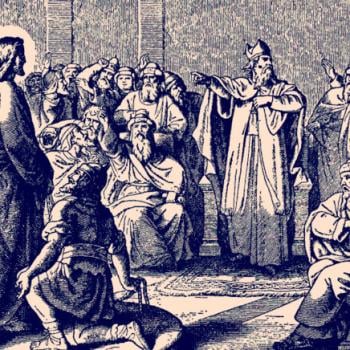Upending the economy. The Marxist comic book. And how to thwart a black mass.
Upending the Economy
President Trump has pulled the trigger on his threat to impose tariffs on all the world. I wish him the best, but I have long been a skeptic about tariffs. (See my post from last year entitled Why Tariffs Cannot Work.)
The very announcement of the tariffs–10% on all countries, up to 50% on those with whom we are running a trade imbalance–sent the stock market into free fall, with the Dow dropping 4,000 points in two days, the largest point drop in history, giving the stock market a bigger hit than the COVID shutdown.
President Trump keeps talking about how these different countries will have to pay the tariffs, but it’s American importers, whether companies or individuals, who will have to cough up the money to the federal government. That will hurt the exporting companies, of course, because fewer Americans are likely to buy their products. And those companies importing goods whose costs have shot up at least 10% and likely more will have to pass along that increased expense to American consumers. Tariffs always raise prices because they wouldn’t work otherwise, not only because of the extra percentage tacked on, but because if American companies don’t have to compete with cheaper foreign goods, they can raise their prices as well.
President Trump called the extra percentages some countries will have to pay “reciprocal” tariffs, explaining that we are simply charging those countries the same duties that they charge us. I think that’s a good idea, actually! It’s only fair. But these percentages are actually not based on what those countries impose on American goods! They are calculated by dividing our trade deficit with that country by the amount of the goods that we import from that country, then dividing that by half. Dominic Pino points out that South Korea is hit with a 25% tariff, even though it charges the United States almost nothing! But we have a trade deficit with South Korea of $66 billion and we import $132 billion worth of goods, which comes to 50%, with the “kind” discount of half, yielding 25%. (Is it possible that President Trump’s advisors just came up with an algorithm instead of doing the work to see what the tariffs on U.S. goods actually are?)
Other questions arise: How can a President determine tariff rates? Isn’t that the job the Constitution specifically assigns to Congress in Article 1, section 8, which reads, “The Congress shall have Power To lay and collect Taxes, Duties, Imposts and Excises.” Yes, but back in 1977 Congress passed the International Emergency Economic Powers Act, giving the president lots of authority over the economy during an international emergency, though President Trump is the first one to use that power to implement tariffs. The international emergency the president invoked is the influx of the deadly drug Fentanyl because of lax border security, but does that emergency apply to the whole world?
Fortunately, though goods from Mexico will have a 25% tariff, that will not apply to agricultural products, which are duty free because of the NAFTA update that President Trump negotiated in his first term. That means American supermarkets will still be able to get at least some fresh fruits and vegetables year round, even when it isn’t the growing season here in the northern hemisphere.
Having criticized the tariffs, I can see, though, that they may have some beneficial effects. Already some major international companies–such as Honda, Hyundai, Pfizer, and others–have announced plans to build manufacturing plants to the U.S. to avoid the tariffs. And some major American companies, such as Apple and Johnson & Johnson, have announced plans to shift manufacturing from overseas back to the United States.
That’s the sort of thing that the president is counting on. But it takes awhile to build, staff, and operate new factories. The question is, can the American economy and the American people put up with higher prices, supply-chain shortages, and layoffs in our export industries long enough for any possible benefits to kick in?
The Marxist Comic Book
The vibe may have shifted regarding DEI and neo-Marxist Critical Theory, but they aren’t dead yet. Minnesota public schools, with the support of Tim Walz, the state’s governor and the Democratic vice-presidential candidate, have added “racial capitalism.” to meet the state’s social studies standards.
What, you might wonder, is “racial capitalism”? Stanley Kurtz helps us understand in his article Tim Walz and the Marxist Comic Book. Kurtz discusses how Minnesota is incorporating critical race theory into its required school curriculum, with much of the input coming from a group of radicals from the University of Minnesota. One of the resources that group recommends is a comic book entitled Racial Capitalism and Prison Abolition.
Read it at the link! The comic is not just “post-Marxist” but actual Marxist. Here is Kurtz’s summary:
The American system produces inequality through capitalist private ownership, which concentrates the vast majority of wealth into the hands of a tiny few, enabling them to effectively steal the labor of everyone else. Capitalist exploitation is backed up by the state, which holds a monopoly on violence. The state gets to define what kinds of violence are permitted and which are not (“illegal” immigration, for example). The police and the military back up the state yet are unaccountable to the communities they patrol. Today’s police, in fact, directly descend from the runaway-slave patrols of old. The entire American system is thus inherently unjust.
Furthermore, the comic book continues, the capitalist system uses the idea of racial superiority to solidify its exploitation of the working class. The idea of racial differences foments conflict, thereby preventing the working class from uniting to throw off its exploitative capitalist masters. The state also criminalizes poverty by classifying basic survival techniques like shoplifting or fare evasion as illegal. In effect, capitalism both creates poverty and criminalizes the condition of being poor. In the service of capitalism, the state also warehouses the masses of poor unemployed persons in prisons. Large-scale incarceration thereby reduces the risk of a mass uprising of the unemployed against the system.
Will Minnesota schools actually use this particular comic book? Maybe not, but it’s a resource on the subject. And Gov. Walz is doing everything he can to shield the curriculum and its textbooks from the public eye.
But the comic book is telling for another reason, revealing as it does the connection between various progressive policies, the way their proponents think, and the ideology that looms behind it all. Says Kurtz:
[The comic book] really does help to explain support for Democrat-backed policies that are often nowadays dismissed by conservatives as simply crazy. Why do so many Democratic prosecutors refuse to prosecute crimes? Why no cash bail? Why California’s refusal, until only very recently, to punish shoplifting? Democrats seem to have distanced themselves from slogans like “defund the police,” but the zine provides a rationale for precisely that policy. Remember, this is Minnesota, where the George Floyd incident occurred and where calls to abolish the police first broke out. The radicals behind that movement are the radicals behind Governor Walz’s ethnic studies standards. This is what they believe.
How to Thwart a Black Mass
A group of Satanists had been planning to carry out a Black Mass at the Kansas State Capitol in Topeka. This is a blasphemous mockery and inversion of the Christian liturgy, the high point of which is the ritual desecration of a consecrated Host that had been stolen from a Catholic communion service, usually by a Satanist posing as a Christian who received the host without swallowing it.
The organization Satan’s Grotto in Kansas claimed to have acquired a consecrated host and trumpeted their intention to use their freedom of religion to desecrate it in the state capitol. Legal challenges ensued, the group was not allowed in the Capitol building, so the Satanists moved it outside, to the Capitol steps.
At the appointed time, March 28, a few dozen Satanists were met by hundreds of Catholic protesters. As John Daniel Davidson tells it, when the Satanist “priest,” Michael Stewart threw the Host on the ground preparatory to stomping it, a Catholic layman named Randy Blasi rushed up, dove on top of what He believed to be the Body of Christ, and consumed it. The Satanists started hitting him. Stewart retreated into the Capitol building to at least read the rest of the sacrilegious liturgy, whereupon a young man named Marcus Schroeder ripped the pages out of his hands. Stewart then punched him twice in the face, knocking him down. Police swarmed in, tackled Stewart, handcuffed him, and hauled him off to jail as he cried out “Hail, Satan!”
P.S.: We Lutherans agree with the Catholics that the bread and wine in Holy Communion actually are the Body and Blood of Christ. But only in the context of its divinely-appointed use. That is, in the context of the Divine Service. (See Solid Declaration of the Formula of Concord, VII, 83-87).) But I think we can still appreciate those Catholics in Topeka.


















